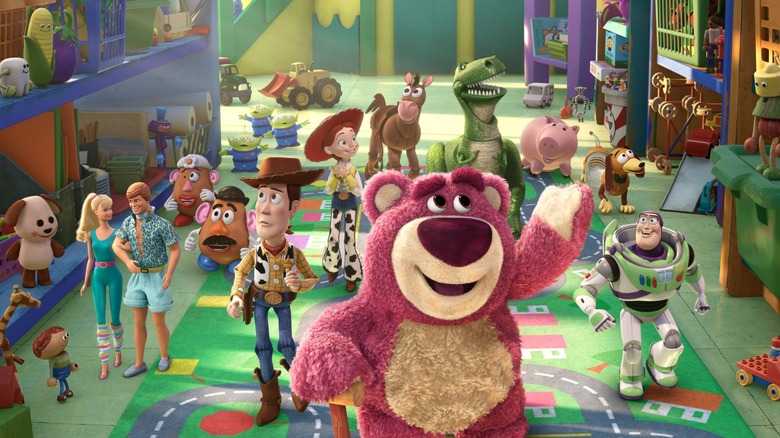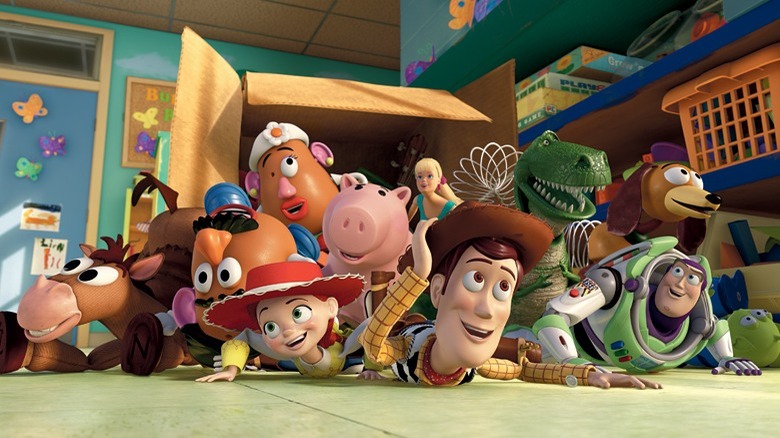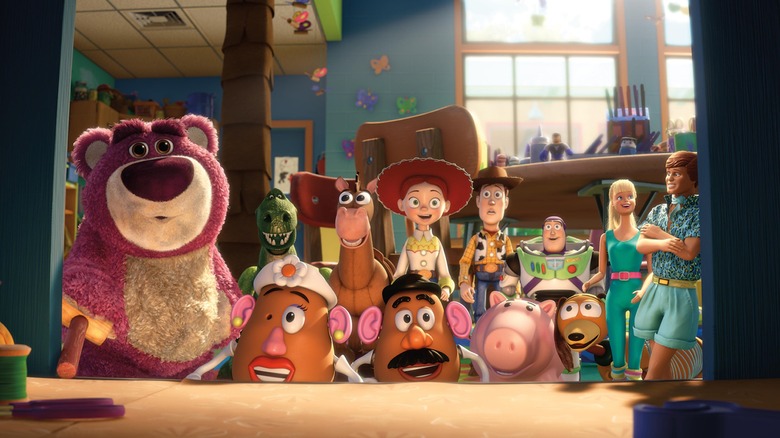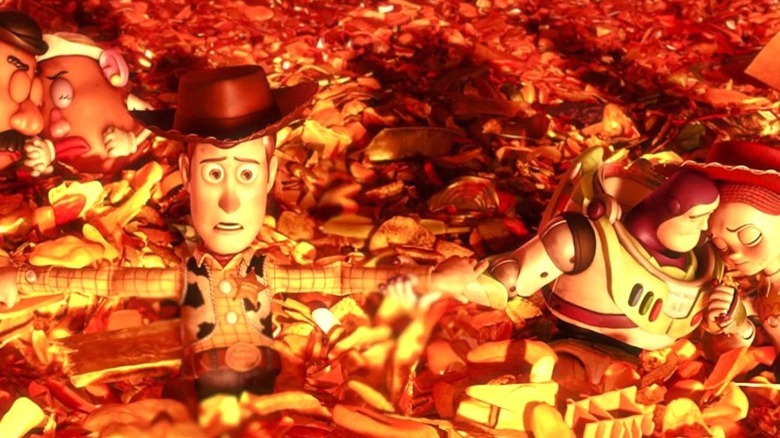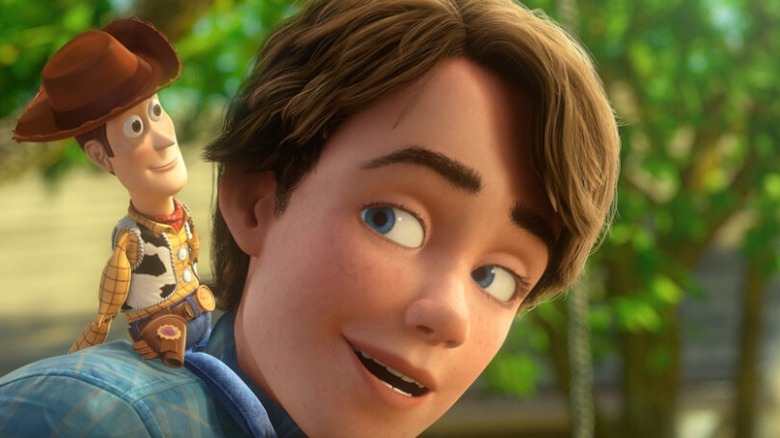Toy Story 3 Ending Explained: So Long, Partner
With 2010's "Toy Story 3," Pixar and director Lee Unkrich were faced with punishingly high expectations. Besides the first two entries in the series being certified modern animated classics, there was also the question of purpose. For Pixar, a production company known at the time for its refusal to do sequels unless there was a story to justify one, to do a sequel over a decade after the previous entry, something good must have been in store.
The original "Toy Story," which was released in 1995, changed animation forever. Its 1999 sequel — a moving allegory for the stages of life — managed somehow to be even better. A follow-up couldn't simply take viewers back to the world of toy cowboy Woody (Tom Hanks) and toy astronaut Buzz (Tim Allen). Nor could it take the eventual route of "The Incredibles 2," which ignored the gap in time between movies. The series was always surprisingly deep, with its neurotic toys living in awareness of the limited amount of time they would be deemed valuable by their owner (or their "kid") Andy (John Morris). For the movie to work, all of those things would need to be considered.
So time passed in the world of the movies. Rather than returning again as the young child who stood in for every young child in the early movies, Andy was now a young adult preparing to move out for college. And what's a young man going to do with all of his childhood toys?
In the garbage
He leaves them behind. While the movie opens with a thrillingly rendered Western scene of the toys at the height of Andy's imaginative powers, that's just a prologue. It transitions to modern day accompanied by a distorted version of Randy Newman's classic song for the first movie, "You've Got a Friend In Me." Where the toys were once perpetually laid around on Andy's floor, they're now nowhere to be found. Many have disappeared, leaving only Woody, Buzz, Jessie (Joan Cusack), Mr. Potato Head (Don Rickles), and a handful of others.
With Andy on the verge of leaving for college, he has little interest in the old toys, a fact that has disillusioned them. When all but Woody are thrown into a trash bag for storage, they take it as a sign that they are really on the outs. And when Andy's mom thinks the bag is just trash and leaves it with garbage, they get collected by a truck. Woody eventually reunites with the others, trying to get them to come back to Andy's home. In the process, all of them end up in a daycare, reflecting a sort of circle of life for the toys — they're lucky to be loved by a child who eventually outgrows them, forcing them into irrelevance until, maybe, some other kid finds them.
The daycare at first seems like paradise for the toys, as the notion builds in their heads that they'll always have kids who want to play with them. That's certainly what the daycare toys' head honcho, a fluffy pink lawsuit-causing teddy bear by the name of Lots-O'-Huggin' Bear (Ned Beatty) wants them to think.
Lotso the dictator
Lotso, as he's colloquially known, has less than pure intentions, holding court over the daycare as a bitter dictator, his feelings never healed after he was abandoned by his kid. Even Ken (Michael Keaton), having successfully wooed Barbie (Jodi Benson), is committed to the Lotso cause. The movie's melancholic tone is traded jarringly for that of a full-blown prison break thriller as the toys work to figure out how to leave. Buzz at first acts as a leader for the toys, but he's soon reset into Spanish mode, a plot point co-writer Andrew Stanton had to fight to keep in. Woody breaks out of the daycare by chance, as the toddler Bonnie (Emily Hahn) takes her back to her house.
It's here that Woody learns about Lotso's backstory from a toy clown named Chuckles (Bud Luckey) in Bonnie's possession. As he plots a rescue attempt for his friends, it's hard not to see that the path forward for the toys may not be returning to Andy, but to end up in the homes of other kids like Bonnie who will actually play with them.
Where's your kid now?
As Woody returns to the daycare with the intention of rescuing the toys, the breakout begins. They attempt to sneak out via a garbage chute into the dumpster, but Lotso refuses to give them an inch. Woody's able to spark a change of heart in Lotso's goons, as Ken switches sides and the Big Baby (Woody Smith) throws the bear into the dumpster, where he will be picked up by a garbage truck.
With the conflict seemingly won, the toys are faced with another reversal of fortune. Lotso gets Woody into the dumpster and his friends follow along, unwilling to let him go alone. The garbage truck picks up the dumpster, and takes the toys to a garbage incinerator, one from which Lotso escapes while all of the beloved toys are left to burn.
As the toys, their eyes as expressive as CGI plastic can be, continue to fall closer to the fire, they accept their fates. Given that the movie is so directly about facing age and the consequent neglect from people you love, this makes for one of the most brutal children's movie scenes of all time. The idea that all the characters will die, learning that their friendships and shared sense of community are all they have, makes for a deeply emotional scene, one that has melted cold hearts ever since the movie came out.
Playtime
Of course, death was never on the table. This is a Disney movie for children, one with a wildly marketable toy line. But any viewer watching that scene understands the stakes, which is what matters.
As the little green alien toys of the original "Toy Story" rescue the toys with a massive industrial claw (calling back beautifully to their first appearance in a claw game), the toys are saved. They can make it back to Andy, but Woody, having realized they would be better suited in the home of a child, leaves a note for Andy to donate the bunch of them to Bonnie. He spends one last sunny day playing with his toys in Bonnie's front yard, reliving the many cherished memories they gave each other. Rather than obsess over mortality or obsolescence, this bittersweet scene gives every character the chance to move on. The good times will always be there for all of them, but now, instead of being locked up in a vault, the toys will be actively loved.
Woody's neuroses over Andy were a key part of his character from the very first movie, where his jealousy of Andy's relationship with Buzz led to resentment. By the second film, his fears were compounded by a tear in his fabric. Now, he's able to move on to a new owner without fear. Aging up Andy was one of the savviest moves executed by writers Lee Unkrich, Andrew Stanton, and John Lasseter. Somebody who saw the first film as a toddler could have seen this movie as a teenager or young adult, so it became fundamentally a movie about growing up, and all the consequent pain and joy.
